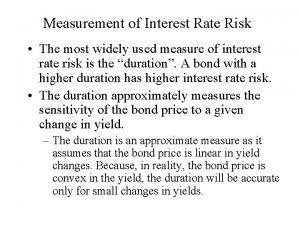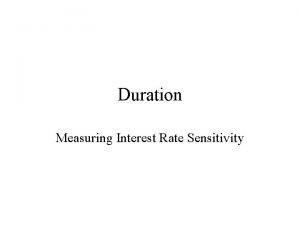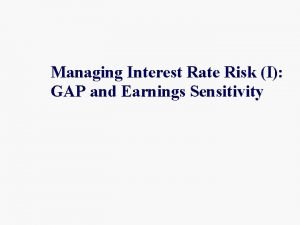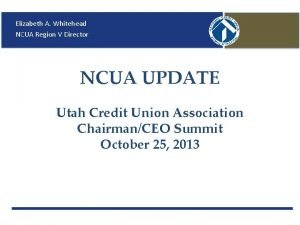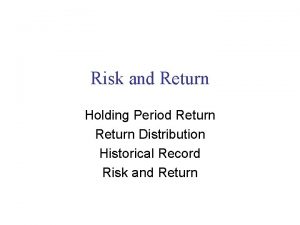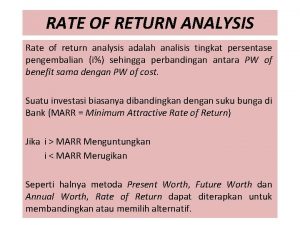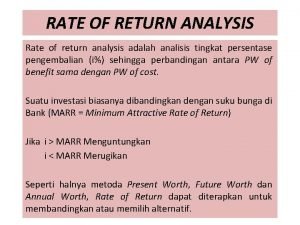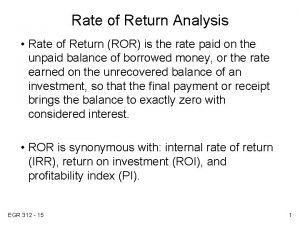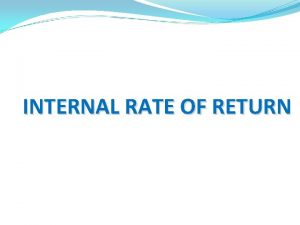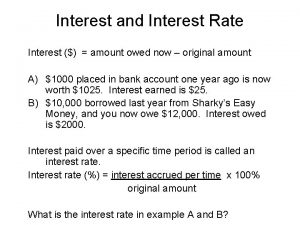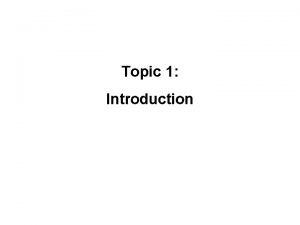Managing Interest Rate Risk Risk vs Return l













- Slides: 13

Managing Interest Rate Risk

Risk vs. Return l As a portfolio manager, your job is to maximize your risk adjusted return Risk Adjusted Return = Nominal Return – “Risk Penalty” You can accomplish this by 1 of two methods: 1) Maximize the nominal return for a given level of risk 2) Minimize Risk for a given nominal return

The one year interest rate is currently 5% and is expected to stay constant. Further, there is no liquidity premium Yield 5% Term P $5 $5 + + = 2 3 4 (1. 05) … = $100 All 5% coupon bonds sell for Par Value and YTM = Coupon Rate = Spot Rate = 5%

Available Assets 1 Year Treasury Bill (5% coupon) l 3 Year Treasury Note (5% coupon) l 5 Year Treasury Note (5% coupon) l 10 Year Treasury Note (5% coupon) l 20 Year Treasury Bond (5% coupon) l STRIPS of all Maturities l How could you maximize your risk adjusted return on a $100, 000 Treasury portfolio?

Suppose you buy a 20 Year Treasury $100, 000 P(Y=5%) = 20 Year $5000/yr $105, 000 $5000 + + + 2 3 (1. 05) $4, 762 1+ $100, 000 $4, 535 2 + $100, 000 Macaulay Duration = 12. 6 … + $4, 319 $100, 000 $105, 000 (1. 05) 20 $39, 573 3+ …+ $82, 270 $100, 000 20

Alternatively, you could buy a 20 Year Treasury and a 5 year STRIPS $50, 000 20 Year $2500/yr 5 Year $63, 814 $52, 500 5 Year $63, 814 (Remember, STRIPS have a Macaulay duration equal to their Term) Portfolio Duration = $50, 000 12. 6 + $100, 000 $50, 000 $100, 000 5 = 8. 8

Alternatively, you could buy a 20 Year Treasury and a 5 year Treasury $50, 000 20 Year $50, 000 5 Year $2500/yr 5 Year $52, 500 (5 Year Treasuries have a Macaulay duration equal to 4. 3) Portfolio Duration = $50, 000 12. 6 + $100, 000 $50, 000 $100, 000 4. 3 = 8. 5

Even better, you could buy a 20 Year Treasury, and a 1 Year T-Bill $2500/yr $50, 000 20 Year $50, 000 1 Year $52, 500 … (1 Year Treasuries have a Macaulay duration equal to 1) Portfolio Duration = $50, 000 12. 6 + $100, 000 $50, 000 $100, 000 1 = 6. 3

Alternatively, you could buy a 20 Year Treasury, a 10 Year Treasury, 5 year Treasury, and a 3 Year Treasury $25, 000 D = 12. 6 20 Year $25, 000 D = 7. 7 10 Year $25, 000 D = 4. 3 5 Year $25, 000 D = 2. 7 3 Year $25, 000 $100, 000 $1250/yr 12. 6 + $25, 000 $100, 000 Portfolio Duration = 6. 08 7. 7 + $25, 000 $100, 000 4. 3 + $25, 000 $100, 000 2. 7

Obviously, with a flat yield curve, there is no advantage to buying longer term bonds. The optimal strategy is to buy 1 year T-Bills $100, 000 1 Year … $105, 000 Portfolio Duration = 1 However, the yield curve typically slopes up, which creates a risk/return tradeoff

Also, with an upward sloping yield curve, a bond’s price will change predictably over its lifetime

A Bond’s price will always approach its face value upon maturity, but will rise over its lifetime as the yield drops Pricing Date Coupon YTM Price ($) Issue 2005 2006 2007 2008 2009 2010 2011 3. 87% 3. 69 3. 48 3. 28 3. 04 2. 78 2. 55 Matures 100. 00 100. 96 101. 77 102. 20 102. 35 102. 11 101. 29 100. 00 3. 75% 3. 75 3. 75

Also, the change is a bond’s duration is also a non-linear function Length of Bond Initial Duration Percentage after 5 Years Change 30 Year 20 Year 15. 5 12. 6 7. 8 14. 2 10. 5 4. 4 -8% -17% -44% As a bond ages, its duration drops at an increasing rate
 What is real interest rate and nominal interest rate
What is real interest rate and nominal interest rate Cap rate interest rate relationship
Cap rate interest rate relationship Measure interest rate risk
Measure interest rate risk Hedging interest rate risk with futures
Hedging interest rate risk with futures Interest rate risk sensitivity analysis
Interest rate risk sensitivity analysis Sensitivity analysis interest rate risk
Sensitivity analysis interest rate risk Interest rate risk
Interest rate risk Ncua aires questionnaire
Ncua aires questionnaire Your uncle would like to restrict his interest rate risk
Your uncle would like to restrict his interest rate risk Risk projection
Risk projection Effective rate of interest
Effective rate of interest Simple and compound interest
Simple and compound interest Market risk credit risk operational risk
Market risk credit risk operational risk Nominal rate of return
Nominal rate of return


